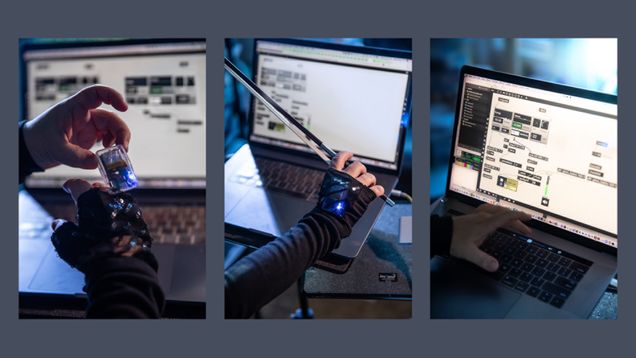音乐先锋
木村玛丽(Mari Kimura)来到波士顿大学学习小提琴表演,离开时成为了艺术与科技交叉领域的创新者
Joel Brown b| Conor Doherty摄影
Mari Kimura grew up outside Tokyo in a solar house, one of the first in Japan. 她的父亲是一名建筑教授和太阳能先驱,总是在试验,在她小的时候,1973年的石油危机让他出名,并吸引了电视摄像机来到他们家。
One day, “I remember so clearly playing outside in the cold winter light with a friend, and my shadow was very long,” says Kimura (’88). “我看到了我房子的影子,还有这种不应该在那里的拱门。So I look up, and it’s water gushing out of the solar panels because the pipes froze and erupted. 我冲进房子告诉父亲:“房子里有水出来了!”You have to go up on the roof and fix it!我简直要发疯了。And to my astonishment, he ran around the house shouting, ‘Where’s my camera?修理并不是他的首要任务,他必须把它记录下来。
“I grew up like that,” says the violinist, composer, and tech innovator, smiling. “在某种程度上,实验是我的血液。”
她现在是加州大学欧文分校克莱尔·特雷弗艺术学院综合作曲、即兴创作和技术项目的音乐教授,她是一位著名的小提琴家,在世界各地与交响乐一起演出,以及她在“次谐波”方面的创新,“次谐波”是一种特殊的弓弦技术,可以产生比小提琴最低弦低一个八度的音符。She was invited to join the faculty at UC Irvine in 2017 in large part because of her growing use of digital technology, particularly motion detectors attached to her bow hand. The feedback she gets from the sensors—metrics such as the angle and acceleration of her arm—guides her own performances or the sounds, lighting, and projections that accompany them, and drives collaborative works with other artists.
She even has her own one-woman company, Kimari LLC, to develop and market her patented motion sensor, called MUGIC® (Music/User Gesture Interface Control), worn by her students at UC Irvine and the summer Atlantic Music Festival in Maine. Wi-Fi传感器可以创造声音,改变灯光,产生和控制视觉效果。Kimura wears the device in a glove on her bow hand; 其他人将其连接到他们的仪器或腕带或脚踝带或其他任何提供相关数据的地方。这种传感器正在哈佛大学、茱莉亚音乐学院和芝加哥大学等院校使用。
“Experimenting was in my blood.”
“Technology works for her in the same way it has worked for great artists for thousands of years,” says John Crawford, a professor of intermedia arts at UC Irvine who’s been collaborating with Kimura since he helped recruit her to the school. 她现在演奏的小提琴一度被视为尖端科技。他们不仅要发明音乐,还要发明演奏的方法。She finds ways of adapting technology to her own creative pursuits.
“The MUGIC device is a perfect example,” Crawford says. “人们以前做过不同类型的运动跟踪,但她找到了一种方法,利用这些小芯片、电池和塑料片的能力来创造新的表达形式。”It’s extremely influential, really interesting, and a lot of fun to work together on.”

Violinist and composer Mari Kimura developed and patented MUGIC® (Music/User Gesture Interface Control), a Wi-Fi motion sensor musicians can use to create sounds, change lighting, and generate and control visual effects.
Kimura also has intellectual roots in the culture of innovation around Boston and Cambridge. Her parents met as Fulbright Scholars on a ship coming to the US; her father, Ken-ichi Kimura, was headed to MIT, and her mother, Aiko Kimura, a social scientist focusing on women’s labor laws, to Mount Holyoke and later Radcliffe. They married in the MIT Chapel, and returned to Japan when Aiko was pregnant. 木村出生于东京。
Kimura graduated with a degree in violin performance from Toho Gakuen School of Music in Japan (which also counts former Boston Symphony Orchestra music director Seiji Ozawa among its alumni) and came to BU to earn her master’s, studying under Roman Totenberg, the late CFA professor emeritus of music and a friend of her undergraduate mentor in Japan. She went on to receive a doctorate in musical arts from Juilliard.
木村说,她对音乐和科技的交集的兴趣,从校园内外就开始了。
她说,为了满足要求,她参加了一门电子音乐课程,她是班里唯一的女性。CFA音乐、作曲和音乐理论副教授塞缪尔·海德里克(Samuel Headrick)向她介绍了一个全新的声音世界,当时主要由模拟合成器产生。
While studying at CFA, she rented a room on Carlton Street in Brookline, near the BU Bridge. 她被马文·明斯基(Marvin Minsky)的社交圈所吸引。明斯基是麻省理工学院已故的计算机科学家,也是该校人工智能和媒体实验室的幕后推手,他就住在附近的常春藤街(Ivy Street)。
“我不知道他有多出名,但我开始在他的厨房里闲逛,”木村说。“I got exposed to all these AI people and creative minds. And he said, ‘Oh, so you’re a violinist? 如果你失去了你的手,你打算怎么办?You should start composing.’ And I’m like, ‘Who is this crazy person?’”
Together, Headrick’s class and Minsky’s prodding changed the course of her career. 她了解了已故哥伦比亚大学作曲教授马里奥·达维多夫斯基(Mario Davidovsky)的开创性作品,他因将电子声音与原声室内乐结合而闻名。她开始将电子元素融入到自己的作品和表演中。她最终被招募到茱莉亚音乐学院和纽约大学任教,并在斯坦福大学音乐和声学计算机澳门威尼斯人注册网站研究中心担任访问澳门威尼斯人注册网站研究员。
Along the way, she met and married a French mathematician and computer scientist, Hervé Brönnimann, who works in the hedge fund industry. 他们的女儿是加州大学圣地亚哥分校心理学专业的学生,他们的儿子去年高中毕业后加入了美国陆军预备役。
她将MUGIC推向市场的工作促使她在加州大学欧文分校(UC Irvine)攻读emba,她的学生队伍中包括几名退伍军人,她说,他们“成为了我这个母亲的支持小组,对我说,‘无论白天还是晚上,你都可以给我们打电话。’”
Kimura says she had moments early in her career where as a woman she may have been held back by the culture of the field. 一位杰出的白人男性教授问某人:“谁为玛丽编写了声音?”’ thinking I wouldn’t be able to do it myself. I don’t think it was gender prejudice. It’s more like, ‘How can a violin player program for herself?’ The friend who got asked was more upset than I was.
“I have this image in my head of myself: I’ve been doing this very unusual thing for a classically trained violinist, and I have to have this huge machete to cut through the jungle and carve out the road I want to walk on,” she says. “所以我想,如果我把砍刀给另外五个人,我们一起做这件事,那么我们后面的人就可以走得更远更快。That’s why I teach.”










